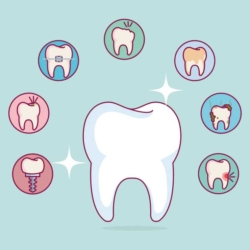Braces are orthodontic treatments intended to straighten malocclusions of the teeth. There are a few different types, and you can consult your dental professional to determine the best course for correction, based on your lifestyle, how disciplined you are, and the amount of work necessary.
When your teeth aren’t aligned properly, it can increase the risk of developing cavities and gum disease. It is more difficult to clean teeth when they are crowded or overlapping. Proper orientation also reduces the incidence of chewing issues. Having a beautiful smile with perfectly straight teeth not only improves oral health and function but also boosts confidence and self-esteem. Press on this link and visit our website and schedule a consultation with an expert.
Types of Malocclusions:
- Overbites occur when the upper front teeth extend beyond the lower set.
- Underbites are characterized by the front bottom teeth that extend outward farther than the top set.
- Cross-bites are defined by individual lower teeth that sit on the outside of your upper teeth.
- Open bites happen when your upper and lower front teeth don’t touch or overlap.
- Crowding.
- Gaps and spaces.
Types of braces
Traditional metal braces are the most commonly used variety using metal wires and brackets attached to the front of teeth. They are the least expensive but are quite noticeable.
Ceramic braces are the same shape and size as traditional braces, but instead, the brackets are tooth-colored or clear, and the wires might be frosted to blend into teeth. They are expensive compared to metal braces and are reported to stain easily if not cleaned properly.
Lingual braces work similarly to traditional braces, except the brackets and wires are placed on the inside of teeth. They are invisible from the external view but are challenging to clean and might be more uncomfortable.
Clear braces straighten your teeth but are more discreet than the alternatives. There are variations of see-through components similar to traditional braces and there are clear orthodontic aligners, such as Invisalign®, ClearCorrect®, Spark®, and uLab®. Clear braces are weaker than metal braces, so expect that they might take slightly longer to fully correct malocclusions.
Clear braces are more prone to discoloration. To reduce staining:
- Minimize dark-colored foods and drinks, like coffee, red wine, and tomato sauce.
- Brush well and floss daily to reduce plaque and tartar.
- Quit smoking
- Visit your dentist or hygienist for routine cleanings.
About Invisalign®
Clear aligners have grown in popularity mostly because of their transparency. The oldest and best-known brand, Invisalign® was introduced to the market in 1998 by Align Technology. It is made of SmartTrack, a flexible thermoplastic material that isn’t completely invisible, but the series of customized plastic aligners are much less noticeable than traditional braces.
Pros
Aesthetics
Invisible braces are much less obvious than the wires and brackets of metal braces.
They can be removed
Invisalign® is removable but it is important to wear them for most of the day to be effective.
Does not inhibit diet
With traditional braces, you’re restricted with what you can consume because certain foods can cause damage or get stuck on the parts. With Invisalign, you can dislodge the tray when you eat, so there shouldn’t be any related limitations.
Cleaning Your Teeth Is Simple
If you have braces, the maze of wires and bands can make it challenging to brush well. Invisalign® makes it possible to reach and clean all parts of your teeth by removing the aligners.
They are more comfortable
There might be slight soreness while the teeth adjust with aligners, but you won’t have any metal mechanisms to prick or cut the inside of your mouth.
Cons
Invisalign® requires compliance
With braces, you have no choice but when to wear them as they’re glued to your teeth. Since aligners are removable make sure to stay disciplined and consistently use aligners for at least 20 to 22 hours a day for the therapy to be effective.
Aligners are limited
If you are experiencing more complex or severe problems with your teeth that require significant modification, it might be best to consider other options.
Invisalign® is costly
Invisalign® is usually more expensive than traditional braces, commonly covered by dental insurance. You will probably have to pay out of pocket, with a bill between $3,000 and $5,000.
Should you seek an orthodontist or a dentist for Invisalign® treatment?
If you’re concerned or about tooth misalignment or malocclusion, contact a dentist for an evaluation. If your dentist thinks you’re a good candidate they should refer you to a specialist for straightening teeth.
Originally, Invisalign treatment was created for both dentists and orthodontists to use, however, dentists only require a one-time training course to become a certified provider and may only be able to offer basic aligner treatment. Orthodontists are the preferred professional because they are better trained and more qualified to monitor and modify the diagnosis, rectification, and prevention of misalignment of the teeth. If you do choose an Invisalign dentist, be absolutely sure they are legally and ethically able to provide you with safe and excellent care for your needs.
What to expect when wearing clear aligners
Your dental professional will create a 3-D image of your mouth and use the image to put together a strategy to fix any malocclusions. A set of aligners will be switched for a new one approximately once every week or two.
Typically, you’ll need to wear the aligners for 20 to 22 hours a day to apply enough pressure to your teeth to gradually shift them into the desired places. The only time you’re supposed to remove the aligners is when you’re eating, drinking, brushing or flossing your teeth, or cleaning the apparatus Avoid using very hot water when washing your aligners; it could warp the plastic material and alter the fit, and success of the therapy
It may take longer for Invisalign to work, compared to other orthodontist treatments. Effectiveness is impacted by factors like gender, age, and the intricacy of work that needs to be done.
Keeping your gums and teeth in top condition with proper oral hygiene is vital if you wear braces. Always keep your mouth clean and healthy. Continue to brush and floss every day and stop by your dentist regularly for thorough examinations and cleanings.






